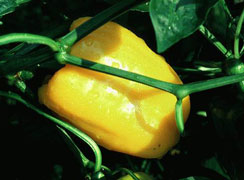


Home
Flowers &
Indoor Plants
Fruits & Nuts
Ornamentals
Vegetables
Special Topics
Resources
Glossary

Peppers |
 |
What about it? Peppers are members of the Nightshade family, along with tomatoes, eggplants, potatoes, and tobacco. Peppers are native to the Americas and grow in tropical areas as a perennial. Northerners grow an annual variation because peppers are very sensitive to cold and wet conditions. Many people do not realize that the green pepper is actually an immature red, gold, or bronze sweet pepper. What is it used for? The fruit of the pepper plant is edible, and is high in vitamin C. The green parts of the members of this family (leaves, stems, and unripe fruit), are poisonous. Peppers come in different varieties and in many different colors. They also come in different taste sensations ranging from very sweet to very, very hot. Where does it grow? How do we grow it? Put transplants out in the field only after the last frost date. They need a high germination temperature (80 degrees F) and plenty of sunshine. Peppers will not recover from a cold shock and will produce poorly all season. Set them 12 inches apart, and mulch them. Think about windbreaks if the planting area is very windy. What are its primary problems? Pests usually are not a difficulty with peppers. Aphids may be a problem because they may spread a virus. Occasionally, a corn borer will show up to snack. The cucumber mosaic virus and bacterial leaf spot can be a problem, as well as blossom end rot and sunscald, which are associated with a lack of moisture. Temperatures above 90 degrees F can cause damage to the buds. How do we propagate it? Plant seeds, indoors, 8 to 10 weeks before the last frost date. How do we harvest and store it? Harvest peppers based on their size and intended use. Let some stay on the plant to ripen fully and get the full amount of vitamin C. But don't let all of them remain on the plant since this will prevent further budding. Do not refrigerate your peppers after picking. Put them in a bag to maintain the humidity and store at 45 degrees F.
© Copyright, Department of Horticulture, Cornell University. |
